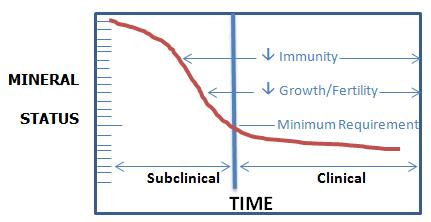It is well established that livestock have certain mineral requirements; however, it is important to understand what those minerals do when choosing a program. Understanding how minerals affect the body may also help in spotting deficiencies and areas of improvement.
Cobalt – Necessary for vitamins B12 synthesis by rumen microbes. A cobalt deficiency results in a B12 deficiency and reduced rumen function.
Copper – Involved in numerous metabolic pathways that affect brood cow health. Of the trace minerals, copper is most often deficient in brood cows. Forage copper levels tend to fall below dietary requirements and antagonists such as molybdenum, iron, and sulfur decrease dietary availability of copper, as well. Tall fescue infected with endophyte tends to be deficient in copper while increasing the animals’ need for copper simultaneously. Copper deficiency can result in compromised immune function and decreased reproductive performance. An outward sign of severe copper deficiency is loss of hair pigment typically showing up as white spots on the brisket or whitening around the eyes.
Iodine – Required by the thyroid gland to make thyroxin (thyroid hormone). Thyroxin is a powerful metabolic regulator, affecting feed intake, growth, and feed efficiency.
Manganese – Needed for various metabolic functions and reproductive efficiencies. Deficiency is rare due to adequate (but variable) manganese concentration in forages. Though deficiency is rare, manganese is often supplemented in trace mineral products for brood cows to ensure appropriate levels for optimum reproductive performance.
Iron – Necessary for hemoglobin formation and also immune function. Iron deficiencies are rare but can compromise immune function when they occur. When iron is in excess it can make some bacterial infections more virulent and reduce the bioavailability of other traces minerals.
Selenium – Works with vitamin E as an antioxidant. Selenium is necessary for normal immune function. Young calves may suffer from White Muscle Disease when deficiency occurs. Available selenium varies widely from pasture to pasture. The window between adequate and toxic levels is less than with other trace minerals, and care should be taken to prevent excessive selenium intake. Selenium should not be supplemented in areas known to have high naturally-occurring levels.
Zinc – Key for hoof health. Zinc is also a cofactor in several chemical reactions, many of which are involved with immune function. Deficiency, or borderline deficiency, is more common in forage diets. Absorption is decreased with excessive levels of manganese and copper. Deficiencies can delay bull puberty and cause decreased reproductive performance.
Organic Trace Minerals
Organic or chelated minerals are more bioavailable to animals. There is extensive research showing positive effects on reproductive performance. Recent research shows better calf performance when born to cows supplemented with organic trace minerals (R. F. Cooke et al., 2015 ASAS Western Section, Ruidoso, NM). There are many types of these trace minerals available on the market. Ideally, organic trace minerals should be supplemented to brood cows 60 days prior to calving until the end of breeding season.

When considering a mineral program, it is important to realize that NRC mineral requirements are the minimum needed for growth and immune support. The requirements for improved reproductive performance are not established and are likely higher than current recommendations. Trace mineral status of the cow herd can affect the health, performance, and reproductive efficiency of the herd. When it comes down to the bottom line, supplementing minerals only makes sense for the health and future of your herd.
Prime Cuts: Why Minerals Matter
Famo Feeds • 446 Industrial Dr • Freeport, MN • 800-450-2145

